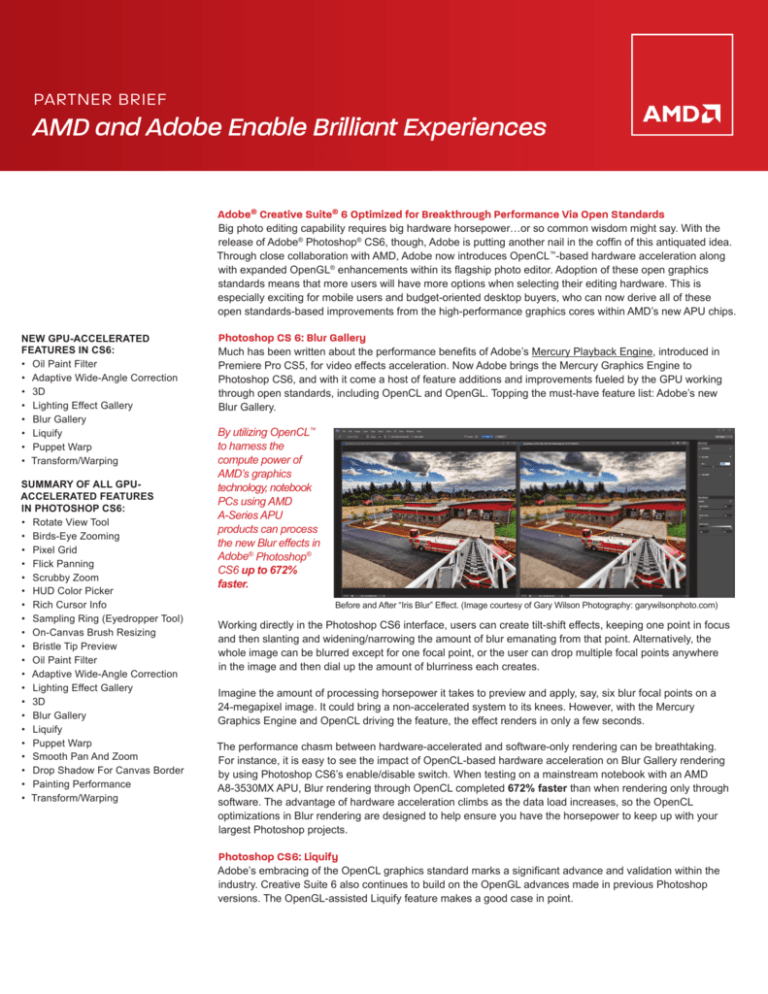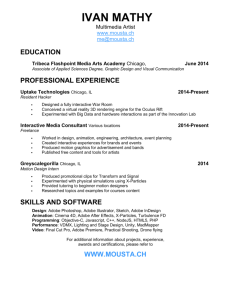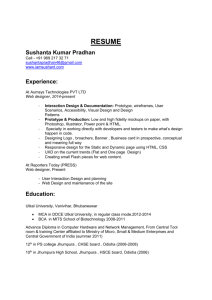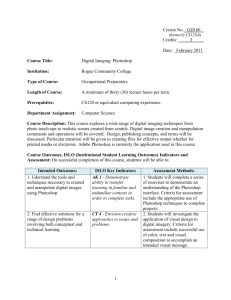
PARTNER BRIEF
AMD and Adobe Enable Brilliant Experiences
Adobe® Creative Suite® 6 Optimized for Breakthrough Performance Via Open Standards
Big photo editing capability requires big hardware horsepower…or so common wisdom might say. With the
release of Adobe® Photoshop® CS6, though, Adobe is putting another nail in the coffin of this antiquated idea.
Through close collaboration with AMD, Adobe now introduces OpenCL™-based hardware acceleration along
with expanded OpenGL® enhancements within its flagship photo editor. Adoption of these open graphics
standards means that more users will have more options when selecting their editing hardware. This is
especially exciting for mobile users and budget-oriented desktop buyers, who can now derive all of these
open standards-based improvements from the high-performance graphics cores within AMD’s new APU chips.
New GPU-accelerated
features in CS6:
• Oil Paint Filter
• Adaptive Wide-Angle Correction
• 3D
• Lighting Effect Gallery
• Blur Gallery
• Liquify
• Puppet Warp
• Transform/Warping
Summary of all GPUaccelerated features
in Photoshop CS6:
• Rotate View Tool
• Birds-Eye Zooming
• Pixel Grid
• Flick Panning
• Scrubby Zoom
• HUD Color Picker
• Rich Cursor Info
• Sampling Ring (Eyedropper Tool)
• On-Canvas Brush Resizing
• Bristle Tip Preview
• Oil Paint Filter
• Adaptive Wide-Angle Correction
• Lighting Effect Gallery
• 3D
• Blur Gallery
• Liquify
• Puppet Warp
• Smooth Pan And Zoom
• Drop Shadow For Canvas Border
• Painting Performance
• Transform/Warping
Photoshop CS 6: Blur Gallery
Much has been written about the performance benefits of Adobe’s Mercury Playback Engine, introduced in
Premiere Pro CS5, for video effects acceleration. Now Adobe brings the Mercury Graphics Engine to
Photoshop CS6, and with it come a host of feature additions and improvements fueled by the GPU working
through open standards, including OpenCL and OpenGL. Topping the must-have feature list: Adobe’s new
Blur Gallery.
By utilizing OpenCL™
to harness the
compute power of
AMD’s graphics
technology, notebook
PCs using AMD
A-Series APU
products can process
the new Blur effects in
Adobe® Photoshop®
CS6 up to 672%
faster.
Before and After “Iris Blur” Effect. (Image courtesy of Gary Wilson Photography: garywilsonphoto.com)
Working directly in the Photoshop CS6 interface, users can create tilt-shift effects, keeping one point in focus
and then slanting and widening/narrowing the amount of blur emanating from that point. Alternatively, the
whole image can be blurred except for one focal point, or the user can drop multiple focal points anywhere
in the image and then dial up the amount of blurriness each creates.
Imagine the amount of processing horsepower it takes to preview and apply, say, six blur focal points on a
24-megapixel image. It could bring a non-accelerated system to its knees. However, with the Mercury
Graphics Engine and OpenCL driving the feature, the effect renders in only a few seconds.
The performance chasm between hardware-accelerated and software-only rendering can be breathtaking.
For instance, it is easy to see the impact of OpenCL-based hardware acceleration on Blur Gallery rendering
by using Photoshop CS6’s enable/disable switch. When testing on a mainstream notebook with an AMD
A8-3530MX APU, Blur rendering through OpenCL completed 672% faster than when rendering only through
software. The advantage of hardware acceleration climbs as the data load increases, so the OpenCL
optimizations in Blur rendering are designed to help ensure you have the horsepower to keep up with your
largest Photoshop projects.
Photoshop CS6: Liquify
Adobe’s embracing of the OpenCL graphics standard marks a significant advance and validation within the
industry. Creative Suite 6 also continues to build on the OpenGL advances made in previous Photoshop
versions. The OpenGL-assisted Liquify feature makes a good case in point.
AMD Partner Brief
AMD and Adobe
worked together on an
optimized Liquify tool
in Adobe® Photoshop®
CS6 that leverages
AMD’s graphics
technology to enable
up to 456% faster
results for Liquify.
Before and After “Liquify” Effect. (Image courtesy of Gary Wilson Photography: garywilsonphoto.com)
The Liquify Effect has been an essential part of Photoshop for the better part of a decade, but as the tool continues to evolve and average image
sizes keep expanding, the processing resources needed to support the filter have become significant. Now with Liquify, you can immediately open
unbelievably large images and start working with more flexibility and options than ever. This capability was impossible without hardware acceleration.
Taking the example of a mainstream notebook PC based on an AMD A8-3530MX, Liquify is up to 456%* faster when accelerated by AMD Radeon™
graphics technology in the APU.
The test in question consisted of a 60.2 MB PSD format source file with an image resolution of 5616x3744. That a sub-$800 notebook can perform
these effects with a file this size at all is amazing; that the AMD Radeon™ graphics core in the APU can complete them so quickly would have been
unbelievable only a couple of years ago.
Other Accelerated Features
Photoshop CS6 continues adding to the list of OpenGL-accelerated features now computed on the GPU. This list began with features including 3D
Lights, Canvas Rotation, Flick-panning, and Zoom Enhancements. CS5 added Scrubby Zoom, the Heads Up Display (HUD) Color Picker, Bristle
Brush Tip Previews, 3D Overlays, and more.
Photoshop CS6 delivers the best OpenGL enhancements yet, starting with an adaptive Wide Angle filter that easily straightens objects warped by
fish-eye or wide angle lenses. A new Oil Painting filter not only provides what its name implies but gives users control over brush style and lighting
parameters. Oil Painting is so demanding that it requires hardware acceleration. The revamped, non-destructive Crop Tool offers an on-canvas
overlay that gives users more precision in maintaining crop dimensions and aspect ratios. Puppet Warp arrived in CS5, but Photoshop CS6 improves
the feature, letting users set “pin” points with which they can reposition image elements, such as bending the angle of a subject’s arms or legs.
Powered by Adobe’s
Mercury Graphics
Engine and AMD
graphics technology,
Puppet Warp lets you
edit with fluid
responsiveness.
Before and After “Puppet Warp” Effect
AMD Partner Brief
Of course, Adobe is not keeping its open standards acceleration bottled up in Photoshop CS6. Premiere Pro and After Effects both make
considerable use of OpenGL in previewing, effects processing, panel displays, rendering, and adaptive resolution processing. However, Premiere
Pro CS6 will deliver the first implementation of OpenCL acceleration in Adobe’s flagship video editor, available at launch on select Apple MacBook
models with AMD GPU’s.
Adobe Flash 11.2 already delivers support for open standards GPU acceleration. This is huge for Web-based gamers and those who publish online
entertainment. In particular, Flash Stage 3D and Flash Stage Video lean heavily on the DirectX® and OpenGL acceleration supported in AMD GPUs
and APUs. Flash Stage 3D delivers console-class gaming by enabling hundreds of times more non z-buffered triangles at twice the frame rate as
prior Flash rendering. Flash Stage Video completely offloads H.264 rendering from the CPU pipeline, facilitating flawless video with greatly reduced
system overhead. GPU-based acceleration can make or break a demanding Flash experience, especially at a time when mobile browsers and thin
client systems are becoming pervasive.
Long-Term Collaboration
Many people have no idea that AMD and Adobe have been cooperating for years, making sure that products based on VISION Technology from
AMD, AMD Radeon™ graphics, and AMD FirePro™ professional graphics offer optimal experiences with Adobe products, such as Photoshop,
Premiere Pro, and Flash. The CS6 generation and Adobe’s move into broader open standards support only take this cooperation another step
higher. For the ten months leading up to Adobe’s Photoshop CS6 announcement, engineers at both companies engaged in daily collaboration.
In fact, AMD often sent teams to Adobe’s offices in order to provide the most thorough support possible.
In assuring peerless compatibility alongside blistering performance, AMD engineers worked hand-in-hand with Adobe, contributing everything from
implementation ideas to hands-on training in implementing open standards. This collaboration has been long in the making, but the fruits of AMD’s
and Adobe’s teamwork are only just beginning. Expect the coming months to bring even more Adobe software features able to leverage AMD’s
graphics acceleration across workstation, desktop, and mobile designs. Photoshop CS6 opens the floodgates to OpenCL and open standards
support; expect even more amazing news from AMD and Adobe.
About AMD
AMD (NYSE: AMD) is a semiconductor design innovator leading the next era of vivid digital experiences with its groundbreaking AMD Accelerated
Processing Units (APUs) that power a wide range of computing devices. AMD’s server computing products are focused on driving industry-leading
cloud computing and virtualization environments. AMD’s superior graphics technologies are found in a variety of solutions ranging from game
consoles, PCs to supercomputers.
About Adobe Systems Incorporated
Adobe (Nasdaq: ADBE) is changing the world through digital experiences. Content built and optimized with Adobe products is everywhere you look,
from websites, video games, and smartphones, to televisions, tablets, and beyond. Adobe Creative Suite offers the most innovative tools for
creating digital media, while Adobe Digital Marketing Suite delivers groundbreaking solutions for data-driven marketing. Our leadership in these two
emerging categories, Digital Media and Digital Marketing, provides our customers with a real competitive advantage, positioning us for continued
growth well into the future.
For more information, visit www.amd.com/adobe
AMD, the AMD Arrow logo, FirePro, Radeon, and combinations thereof, are trademarks of Advanced Micro Devices, Inc. OpenCL and the OpenCL logo are trademarks of Apple, Inc. used by
permission by Khronos. Adobe, the Adobe logo, Creative Suite, Photoshop, and Premiere are either registered trademarks or trademarks of Adobe Systems Incorporated in the United States
and/or other countries. OpenGL is a registered trademark of SGI. Microsoft, Windows and DirectX are trademarks of Microsoft Corporation in the U.S. and/or other jurisdictions. All other names
are for informational purposes only and may be trademarks of their respective owners.
Testing was performed by AMD using test scripts and a 60.2 MB .psd format source file of a 5616x3744 resolution image provided by Adobe. Time to complete a RGB 300 Blur scripted render
test was 51.06 seconds with GPU OpenCL acceleration on versus 394.26 seconds with GPU OpenCL acceleration off. Time to complete scripted Liquify render test was 15.57 seconds with
GPU acceleration on versus 86.62 seconds with GPU acceleration off. Test system was a notebook with AMD A8-3530MX APU with AMD Radeon™ HD 6620G Graphics, 1.9GHz, 4G 1600
DDR3 Memory, Windows 7 Pro, 64-bit. SBNB-I99
© 2011 Advanced Micro Devices, Inc. All rights reserved. AMD, the AMD arrow logo, and combinations thereof are trademarks of Advanced Micro Devices, Inc. All other names used in this
publication are for informational purposes only and may be trademarks of their respective owners. PID 51845-A




